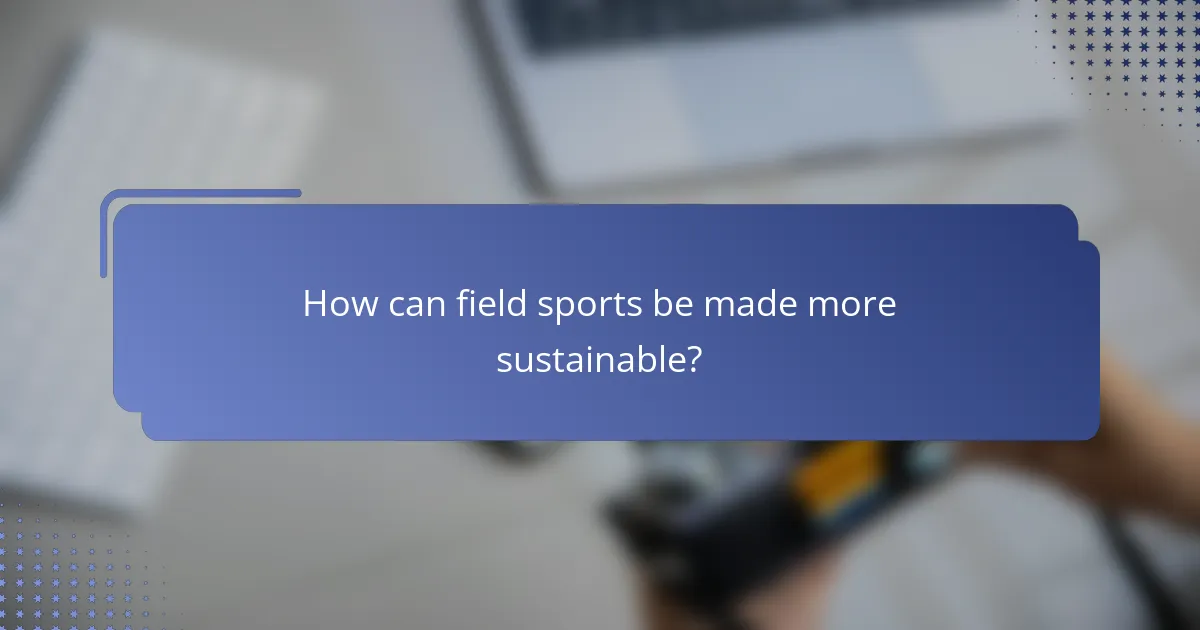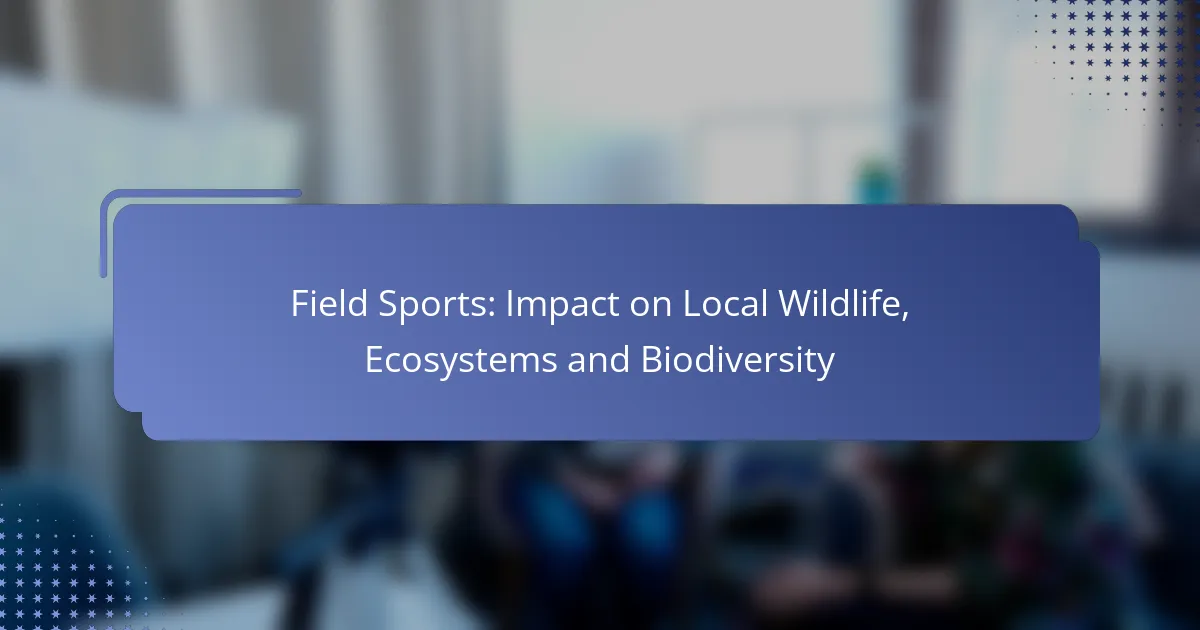Field sports play a complex role in shaping local wildlife, ecosystems, and biodiversity. While they can lead to habitat alterations and disruptions in animal behavior, they also present opportunities for habitat creation and conservation funding. Understanding these dynamics is crucial for balancing recreational activities with ecological health.

How do field sports affect local wildlife in the UK?
Field sports in the UK can significantly impact local wildlife by altering habitats, changing animal behavior, and affecting breeding patterns. These activities often lead to disturbances that can disrupt ecosystems and threaten biodiversity.
Disruption of habitats
Field sports, such as hunting and shooting, frequently result in habitat disruption. This can occur through the trampling of vegetation, the removal of trees, or the alteration of land for access paths and shooting ranges. Such changes can lead to the loss of essential habitats for various species.
Additionally, the noise and presence of humans can drive wildlife away from their natural habitats. Animals may abandon nesting sites or feeding grounds, which can have cascading effects on local ecosystems.
Altered animal behavior
The presence of field sports participants can lead to significant changes in animal behavior. Wildlife may become more nocturnal or alter their feeding patterns to avoid human activity. For instance, deer may shift their grazing times to late at night when disturbances are minimal.
Moreover, repeated exposure to disturbances can increase stress levels in animals, affecting their health and survival rates. This behavioral change can disrupt the natural balance within ecosystems, as animals may avoid areas critical for their survival.
Impact on breeding patterns
Field sports can adversely affect the breeding patterns of local wildlife. Disturbances during critical breeding seasons can lead to reduced nesting success, as birds and other animals may abandon their nests due to human presence. This can result in lower population numbers over time.
Furthermore, habitat alterations can limit the availability of suitable nesting sites. For example, the removal of hedgerows for shooting grounds can reduce the number of safe locations for birds to lay eggs, directly impacting their reproductive success.

What ecosystems are impacted by field sports?
Field sports significantly affect various ecosystems, particularly grasslands, wetlands, and woodlands. These impacts can alter habitat structures, disrupt local wildlife, and influence biodiversity levels.
Grassland ecosystems
Grassland ecosystems are often transformed by field sports through land clearing and soil compaction. Activities like off-road biking or horseback riding can lead to erosion and the loss of native plant species, which are crucial for local fauna.
To mitigate these impacts, sports enthusiasts should stick to designated trails and avoid sensitive areas during breeding seasons. This helps preserve the delicate balance of grassland habitats.
Wetland ecosystems
Wetland ecosystems face unique challenges from field sports, particularly from waterfowl hunting and recreational boating. These activities can disturb nesting sites and lead to pollution from equipment and waste.
Participants should be aware of local regulations regarding wetland use and practice responsible behavior, such as cleaning up after themselves and minimizing noise to protect wildlife. Avoiding wetlands during critical breeding periods is also advisable.
Woodland ecosystems
Woodland ecosystems are impacted by field sports through habitat fragmentation and increased human presence. Activities like mountain biking and hiking can disturb wildlife and lead to the introduction of invasive species.
To protect woodland areas, sports participants should follow marked trails, respect wildlife, and avoid creating new paths. Engaging in community efforts to restore native vegetation can also help maintain ecosystem health.

What are the benefits of field sports for biodiversity?
Field sports can positively impact biodiversity by promoting habitat creation, funding conservation efforts, and engaging local communities in ecological stewardship. These activities often lead to enhanced ecosystems that support a variety of species and encourage sustainable practices.
Habitat creation
Field sports often involve the management of land that can lead to the creation of diverse habitats. For example, maintaining fields for hunting can result in the preservation of grasslands, wetlands, and forests, which are crucial for many species. These managed areas can provide nesting sites, food sources, and shelter for wildlife.
Additionally, sports like fishing and shooting can encourage the restoration of natural habitats. By prioritizing the health of ecosystems, sports enthusiasts can help maintain the balance of local flora and fauna, fostering biodiversity in the process.
Conservation funding
Many field sports generate funds that are directly invested in conservation initiatives. Fees from hunting licenses, fishing permits, and entry fees for sporting events often contribute to wildlife management programs and habitat restoration projects. These funds can be significant, sometimes reaching millions of dollars annually.
Moreover, partnerships between sporting organizations and conservation groups can amplify these efforts. Collaborative projects may include habitat enhancement, species monitoring, and educational programs, all aimed at preserving biodiversity.
Community engagement
Field sports can foster a sense of community and encourage local involvement in conservation efforts. By participating in these activities, individuals often develop a deeper appreciation for their natural surroundings, leading to increased advocacy for wildlife protection. Community events, such as clean-up days or educational workshops, can further enhance this engagement.
Furthermore, local organizations can leverage field sports to promote sustainable practices among participants. Initiatives that educate hunters and anglers about responsible practices can lead to more environmentally friendly behaviors, benefiting local ecosystems and wildlife populations.

What regulations govern field sports and wildlife protection?
Field sports are regulated by various laws aimed at protecting wildlife and preserving ecosystems. These regulations ensure that activities such as hunting and shooting are conducted sustainably and with minimal impact on local biodiversity.
Wildlife and Countryside Act 1981
The Wildlife and Countryside Act 1981 is a key piece of legislation in the UK that provides protection for various species and their habitats. It makes it illegal to intentionally kill, injure, or take certain wild animals and plants, and it establishes guidelines for managing land to support wildlife conservation.
This act also outlines the responsibilities of landowners and sportspeople to ensure that their activities do not harm protected species. For example, specific licenses may be required for hunting certain game birds, and there are restrictions on the use of traps and snares.
Environmental Protection Act 1990
The Environmental Protection Act 1990 focuses on preventing environmental damage and promoting sustainable practices. It includes provisions for waste management and pollution control, which are crucial for maintaining healthy ecosystems that support wildlife.

How can field sports be made more sustainable?
Field sports can be made more sustainable by adopting practices that minimize environmental impact, promote biodiversity, and engage local communities in conservation efforts. This involves implementing best practices, supporting community-led initiatives, and utilizing eco-friendly equipment.
Implementing best practices
Implementing best practices in field sports involves adhering to guidelines that protect local wildlife and habitats. This can include maintaining designated trails to prevent habitat destruction, practicing catch-and-release fishing, and avoiding sensitive areas during breeding seasons.
Sports organizations should educate participants about the local ecosystem and the importance of preserving it. Regular training sessions can help reinforce these practices and ensure compliance among all participants.
Community-led conservation efforts
Community-led conservation efforts empower local residents to take charge of preserving their natural surroundings while participating in field sports. This can include organizing clean-up days, habitat restoration projects, and wildlife monitoring programs.
Collaborating with local conservation groups can enhance these efforts, providing resources and expertise. Engaging the community fosters a sense of stewardship and responsibility towards the environment, making sustainability a shared goal.
Use of eco-friendly equipment
Using eco-friendly equipment is a straightforward way to reduce the environmental footprint of field sports. This includes selecting biodegradable materials for gear, such as fishing lines and camping supplies, as well as opting for sustainable clothing made from recycled or organic materials.
Participants should also consider the energy efficiency of their equipment, such as using solar-powered devices or electric vehicles for transportation. Investing in eco-friendly options not only benefits the environment but can also enhance the overall experience of field sports.

What role do local communities play in wildlife conservation during field sports?
Local communities play a crucial role in wildlife conservation during field sports by actively participating in conservation efforts and promoting sustainable practices. Their involvement helps protect local ecosystems and biodiversity while ensuring that field sports can be enjoyed responsibly.
Volunteer initiatives
Volunteer initiatives are vital for engaging local communities in wildlife conservation efforts associated with field sports. These programs often involve activities such as habitat restoration, wildlife monitoring, and clean-up events, which foster a sense of ownership and responsibility among participants.
For example, local sports clubs may organize regular clean-up days at nearby parks or nature reserves, encouraging members to contribute to the health of the environment. Such initiatives not only benefit wildlife but also strengthen community ties and promote environmental stewardship.
Education and awareness programs
Education and awareness programs are essential for informing local communities about the impact of field sports on wildlife and ecosystems. These programs can include workshops, seminars, and outreach campaigns that highlight best practices for minimizing ecological footprints during sporting activities.
Local schools and sports organizations can collaborate to create educational materials that emphasize the importance of biodiversity and responsible field sports. By raising awareness, communities can better understand how to balance recreational activities with conservation efforts, leading to more sustainable practices.



